La Villa
Palladienne
Un peu d'Histoire
La Villa Palladienne a été édifiée à partir de 1818. Son commanditaire Emmanuel Jobez était le fils de Claude Jobez, Maître de Forges et homme politique reconnu.
Les Jobez, de pères en fils, ont considérablement influencé la vie politique, sociale et économique du Jura au 19ème siècle. Ils ont édifié des usines, des écoles, des églises et des châteaux.
Emmanuel fut l’héritier de ce fabuleux parcours qui commence dans la rude campagne de Bellefontaine où dès 1788 son ancêtre Le Grand Claude se libère de la mainmorte des chanoines de Saint-Claude. ( Servitude qui empêchait les gens de devenir propriétaires ).
L’histoire de la famille Jobez débute au 18ème siècle dans la rude campagne du Haut-Jura à Bellefontaine, les Jobez n’ont ni titre, ni bien, ni aucune richesse, bien au contraire car la famille est frappée de servitude, elle est soumise à la mainmorte des chanoines de Saint-Claude.
En 1788, grâce à son courage et à sa détermination, le grand Claude, père de Claude Jobez et grand-père d’Emmanuel, parvient à se libérer de la servitude qui pèse sur sa famille et permet ainsi à la génération suivante d’être libre.
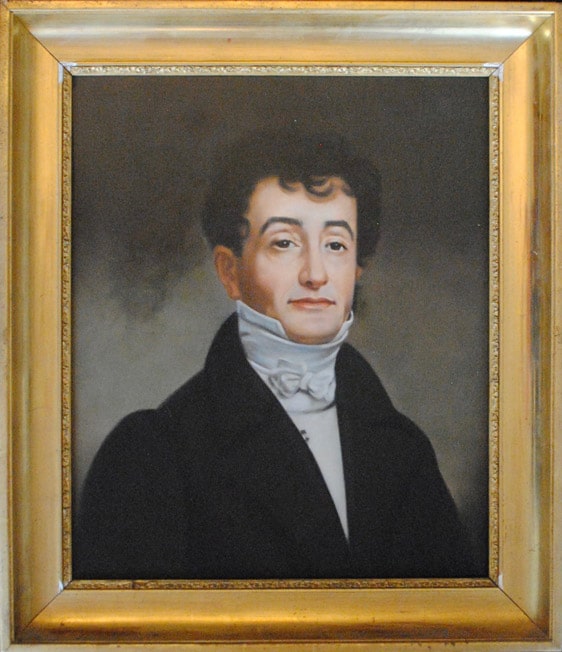
Son fils Claude Jobez fut d’abord paysan, mais rapidement il devint colporteur d’horloges comtoises et grâce à un charisme commercial hors pair, il va se lancer dans les affaires. Dès qu’il en a les moyens, il achète les hauts fourneaux de Rochejean dans le Doubs. Puis ceux de Baudin à côté de Sellières dans le Bas-Jura, ensuite ceux de Champagnole et de Bourg-de-Sirod avant de construire à Syam , au bord de l’Ain, une usine à la pointe de la modernité.
Dans un premier temps, ils ont fabriqué des outils pour l’agriculture au tranchant remarquable .
Ce savoir-faire va permettre à Claude Jobez de devenir fournisseur de Napoléon et de fabriquer des lames pour la guerre, notamment des épées et des baïonnettes ce qui lui permettra de décupler sa fortune. En plus du succès dans les affaires, Claude Jobez obtient la reconnaissance de ses pairs en étant élu Maire de Morez puis Conseiller Général du Jura.
Claude Jobez et sa femme. ont eu deux enfants, Emmanuel et Adélaïde. Ils souhaitent le meilleur pour leur éducation. Emmanuel, doué pour les études entre à la Sorbonne à 17 ans, étudie les lettres, l’architecture, la politique et la musique. Il fréquente des écrivains comme Chateaubriand, Alfred de Musset ,Stendhal, Benjamin Constant ou encore Lamartine. A l’occasion d’un voyage en Italie, il va tomber sous le charme de l’œuvre d’Andréa Palladio, grand architecte de la renaissance italienne. Il va se passionner jusqu’à imaginer faire construire à Syam dans le Jura une réplique de la célèbre Villa Rotonda construite au XVIème siècle à Vicence par le grand Maître pour une famille aristocratique de Venise. Héritier de la plus grande partie de l’immense fortune de son père , il délaissera les affaires de son père au profit de son beau-frère Etienne Monnier pour se consacrer à ce projet et à la politique. Il devient député du Jura en 1815. Il a 30 ans.
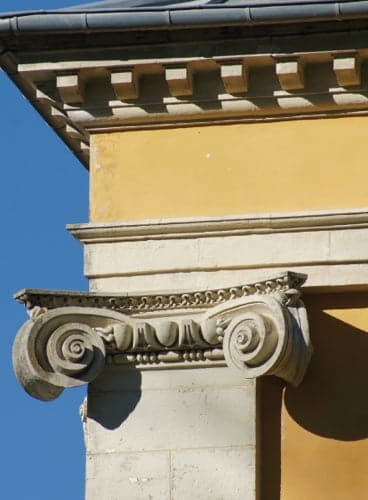
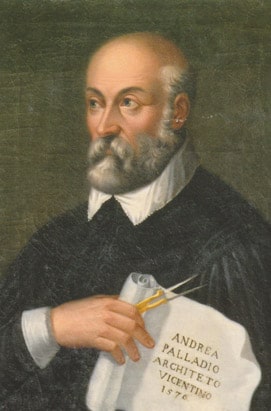
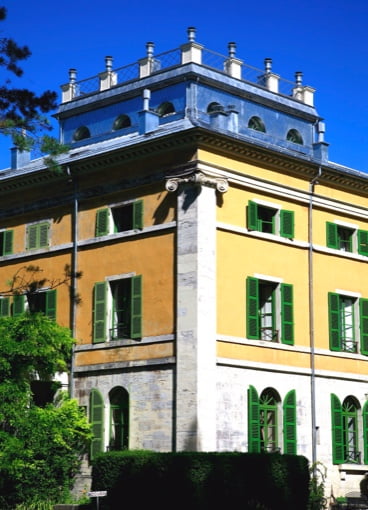
Architecture
Entre néoclassissisme et néopalladiannisme
À mille lieues de l’Italie, plongez dans l’art de vivre des palais vénitiens de la Renaissance à travers cette villa du XIXème siècle, vibrant hommage au Maître Andrea Palladio.
Le néoclassicisme s’inscrit dans la continuité des œuvres classiques de l’antiquité. Dans son ouvrage De Architectura, Vitruve, véritable codificateur de la pratique architecturale de son époque, expose trois qualités essentielles à toute construction: pérenne, utile et belle.
Selon lui l’architecture est une imitation de la nature.
La Villa Palladienne de Syam est une œuvre qui correspond à une conception classique de l’architecture. Andréa Palladio est un architecte italien de la renaissance italienne dont l’œuvre a transcendé les code édifiés par Vitruve. Son attention se porte sur les proportions mathématiques.
Il est mondialement connu pour avoir fait entrer la lumière dans les maisons.
Une conception insolite
Le chiffre 8
La visite de La Villa Palladienne est une succession d’expériences.
Une des plus insolites est la révélation que toutes les côtes de La Villa sont des multiples du chiffre 8.
La maison est un carré de 24 mètres par 24 et de 16 mètres de haut.
8 grandes pièces par niveau, distribuées par une rotonde centrale soutenue par 8 colonnes néoclassiques.
La Rotonde est composée de 4 balcons circulaires donnant sur un plafond de verre. Il y a 8 marches d’escalier pour accéder à la maison et 8 pour accéder aux caves. Au niveau du parc, la maison est située à la jonction des deux ellipses d’un immense 8 qui forme la promenade principale.
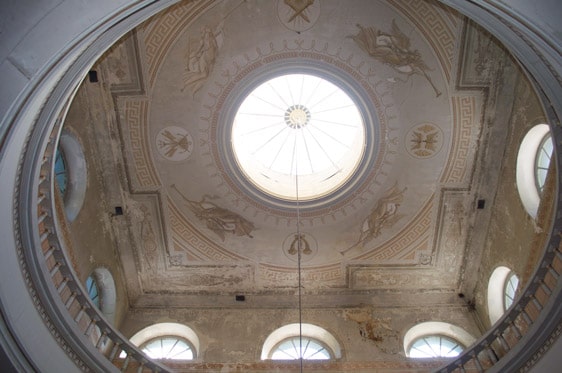
Les arts décoratifs
La collection unique de papiers peints
Véritable trésor de Syam. Il s’agit de la plus importante collection de papiers peints et panoramiques du XIXème siècle dans une maison ouverte au public. Les plus grandes manufactures sont représentées et signent des décors dans un état de conservation extraordinaire. Zuber, Defossé, Leroy, Pierce-Fontaine, Mader, Joseph Dufour… Chaque pièce est un décor unique.
Fresques d’inspiration pompéiennes (chambre de l'évêque, chambre Rose ), histoire de l’antiquité (billard), toile de Jouy… Variété des décors qui racontent l’Histoire politique, artistique et sociale depuis l’antiquité grecque, à l’empire en passant par la période romantique.
Les papiers peints panoramiques se substituent aux fresques peintes et tissus tendus dans un souci de modernité. Dans ces années-là. Le papier peint est un procédé innovant.
Enfin, il existe à La Villa Palladienne de Syam un décor céleste, une fresque peinte directement sur le plâtre dans la coupole de la Rotonde. Des gloires musiciennes et des angelots sont ornés de draperies antiques aux tons sépias d’une infinie beauté.
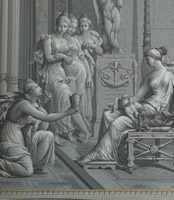
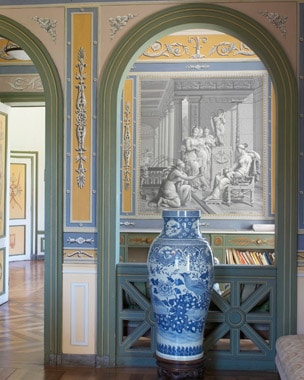
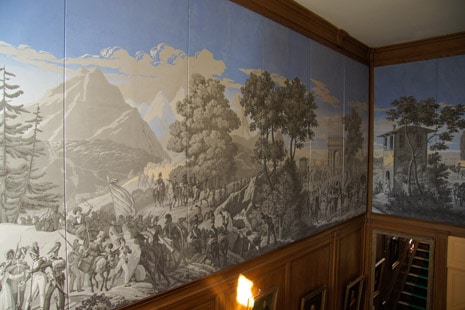
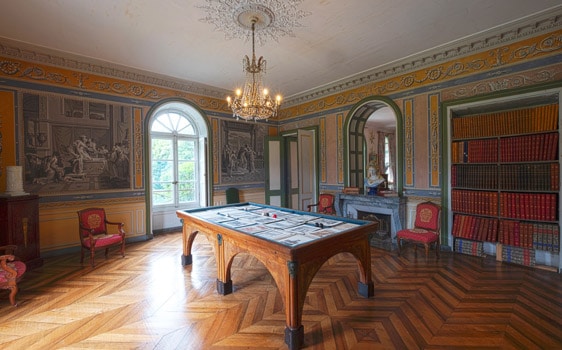
Le mobilier
Entièrement meublée d’époque
La maison bénéficie de son ameublement d’origine, les appartements n’ayant jamais été déménagés : mobilier bourgeois d’époque empire, restauration, Charles X, et Louis-Philippe.
Les acajous de Cuba et les marqueteries précieuses (coiffeuse Boule) en font une collection aussi diversifiée qu’harmonieuse : ébène, poirier, citronnier, bois de rose, amarante, noyer…
Le mobilier est extrêmement confortable. On sent que la priorité pour ses occupants a été la douceur de vivre et le bien-être.
Une décoration parfaitement conservée
Parquets, lustres et ornementations
Les parquets de chaque pièce de La Villa Palladienne sont uniques et représentent à eux seuls des œuvres à part entière. Les meilleurs ébénistes avaient été sollicités pour réaliser ces travaux.
Deux siècles plus tard, leur état actuel, en parfaite conservation, prouve la qualité du travail réalisé.
Réalisés comme des mosaïques, ils se substituent aux marbres et mosaïques des villas italiennes. On mélange des essences de bois différentes pour atteindre des objectifs techniques et esthétiques (acoustique de la chambre de Monseigneur). On obtient des sols aussi beaux qu’en Italie sur lesquels il fait bon vivre toute l’année. Les essences de bois les plus nobles ont été privilégiées : le chêne, le merisier, le sapin, l’érable, le châtaigner…
Les lustres sont des pièces uniques, lustres en cristal de Bohème et bronze doré, lustres empire en tôle peinte et bronze, italien en bois doré, ce qui dénote d’un goût éclectique et très sûr.
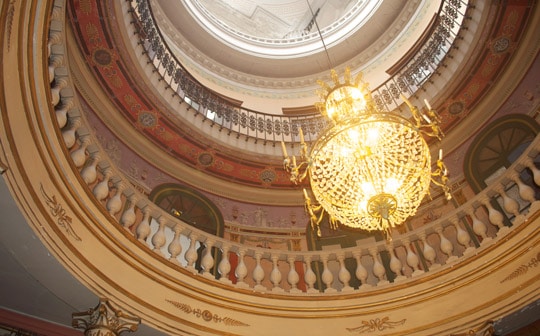
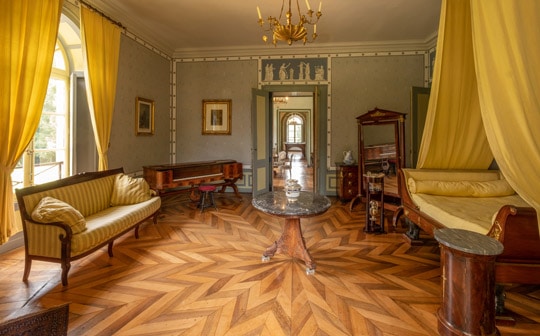
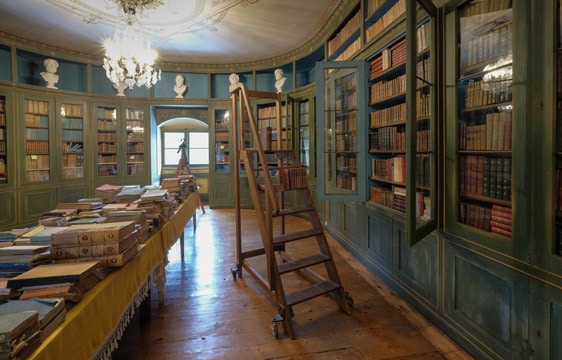
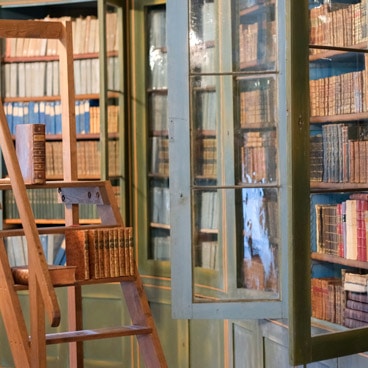
La bibliothèque de Syam
Grâce aux efforts des actuels propriétaires, Brigitte Cannard et Claude Darbon, la remarquable bibliothèque de La Villa Palladienne se reconstitue petit à petit.
A l’époque, au deuxième étage de la demeure, Emmanuel Jobez disposait en effet d’une somptueuse bibliothèque : 24 mètres de long… jusqu’à 36 000 ouvrages !
Les mêmes ouvrages, les mêmes auteurs, aux mêmes endroits de la bibliothèque d’origine, tel est le pari audacieux des actuels propriétaires des lieux !